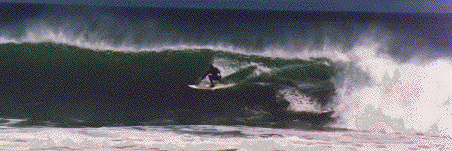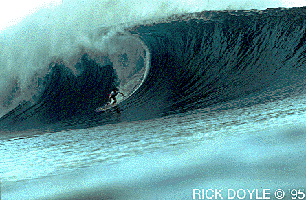Modeling Wind Generated Ocean Waves in Computer Graphics
by Komal Sethi and Larry Cutler
Ocean Waves
Ocean waves are a natural phenomenon that has always been able to
produce breathtaking and beautiful scenes of nature. Pictures of
waves, large crashing ones in particular, can often produce
spectacular results. This wonderous beauty combined with the awesome
destructive power of waves has prompted much study of waves and their
behavior. Engineers have written volumes on the physical behavior of
waves specifying in mathematical detail their behavior. At the same
time photographers and artists have also paid much attention to waves.
For this reason waves are of particular interest to computer graphics,
as they provide a space in which one can combine the physical modeling
of waves with the rendering abilities of computer graphics to generate
images of waves through computer graphics.


Project
For our project we decided to model ocean waves crashing on the shore.
Here are some of our some of our goals:
- reproduce the shape of ocean waves in a realistic fashion
- have the simulation grounded in physical reality
- handle the breaking of waves
- model other interesting phenomena such as randomness and wave refraction
- provide an interactive environment with which users can get controllable simulations
- have the waves lap onto the shore
- produce realistic final renderings
Modeling
In order to model the complex nature of waves we started with a
physical model based on parametric equations that describe the surface
of the waves. For a description of our modeling process go to our implementation page.
Design
In order to design scenes of waves and quickly visualize our model we
implemented an Open Inventor application in which we could quickly see
what different types of waves look like. This interface allowed us to
modulate parameters relating to each of the effects we had added to
the waves. Allowing us for example to turn off variation or increase
the amount of foam and spray generated.
Rendering
To finally bring our model of ocean waves to life, or a sickly
existence at least, we used Softimage's stand alone ray-tracer Mental
Ray, complete with it's fabulous documentation. A discussion of our rendering methods is
available.
Authors:
Komal Sethi (sethi@cs.stanford.edu)
Larry Cutler (larryc@cs.stanford.edu)

